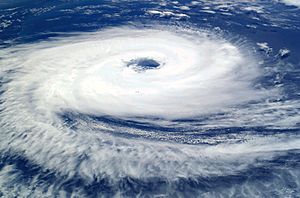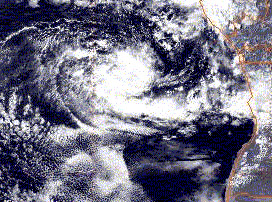South Atlantic tropical cyclone facts for kids
A South Atlantic tropical cyclone is a very rare type of powerful storm. These storms, also known as hurricanes or typhoons in other parts of the world, usually don't form in the southern Atlantic Ocean. This is mainly because of strong wind shear, which means winds blowing in different directions at different heights. This wind shear tears storms apart before they can get strong.
If there were a "hurricane season" in the South Atlantic, it would probably be from December to May. The middle of March would be the busiest time. This is when the ocean waters in the Southern Hemisphere are warmest, which is important for storms to grow.
Contents
What Was Cyclone Catarina?

Cyclone Catarina was an incredibly unusual tropical cyclone. It formed in the southern Atlantic Ocean in March 2004. This storm was so rare that many weather experts thought it was a once-in-a-lifetime event.
After becoming a hurricane, Catarina hit the southern coast of Brazil on the evening of March 28. Its winds were estimated to be around 180 km/h (112 mph). This made it a Category 2 storm on the Saffir–Simpson Hurricane Scale, which measures how strong hurricanes are.
The cyclone caused a lot of damage in Brazil. It also led to the deaths of 3 to 10 people and cost millions of dollars.
Other South Atlantic Storms
While Cyclone Catarina was the most famous, there have been a few other tropical storms or depressions seen in the South Atlantic. These events are also very uncommon.
The 1991 Angola Storm
On April 10, 1991, a storm formed that was either a strong tropical depression or a weak tropical storm. It was seen near Angola.
The January 2004 Storm
In mid-January 2004, a small area of stormy weather began to develop off the coast of Brazil. By January 18, it looked like it had become a tropical depression. The next morning, it had clear bands of clouds and seemed to reach its strongest point. It was located about 150 miles southeast of Salvador, Brazil.
However, this storm quickly weakened. The usual strong wind shear in this area caused it to fall apart. By January 20, it moved inland over Brazil as just a circulation of air, without any strong thunderstorms. It disappeared the next day. Even so, it caused heavy rains and flooding in Brazil.
This storm, along with Cyclone Catarina, made 2004 the first time two tropical cyclones were recorded in the South Atlantic in the same year.
The February 2006 Storm
On February 23, 2006, another small area of stormy weather formed. It was about 600 miles southeast of Rio de Janeiro. This storm moved into an area where the wind shear was low, and the ocean water was warm enough (about 26°C).
The storm had strong thunderstorms and winds of about 56 km/h (35 mi/h). These features were seen for about three hours. However, tropical depressions need to show these features for at least six hours to be officially named. Strong wind shear then started to tear the storm apart, and it disappeared later that night.
Images for kids
See also
 In Spanish: Ciclón tropical en el Atlántico Sur para niños
In Spanish: Ciclón tropical en el Atlántico Sur para niños








